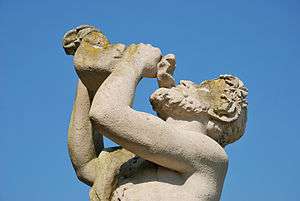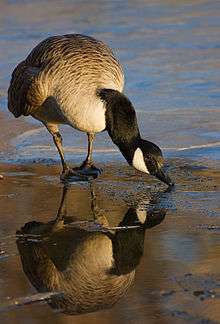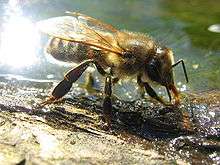Drinking

Drinking is the act of ingesting water or other liquids into the body through the mouth. Water is required for many of life’s physiological processes. Both excessive and inadequate water intake are associated with health problems.
Methods

In humans
When a liquid is poured into an open human mouth, the swallowing process is completed by peristalsis which delivers the liquid to the stomach; much of the activity is abetted by gravity. The liquid may be poured from the hands or drinkware may be used as vessels. Drinking can also be performed by acts of inhalation, typically when imbibing hot liquids or drinking from a spoon. Infants employ a method of suction wherein the lips are pressed tight around a source, as in breastfeeding: a combination of breath and tongue movement creates a vacuum which draws in liquid.[1]
In aquatic animals
Amphibians and aquatic animals which live in freshwater do not need to drink: they absorb water steadily through the skin by osmosis.[2][3] Saltwater fish, however, drink through the mouth as they swim, and purge the excess salt through the gills.[3]
In land animals
By necessity, terrestrial animals in captivity become accustomed to drinking water, but most free-roaming animals stay hydrated through the fluids and moisture in fresh food.[4] When conditions impel them to drink from bodies of water, the methods and motions differ greatly among species.[2] Many desert animals do not drink even if water becomes available, but rely on eating succulent plants.[2]
Cats, canines, and ruminants all lower the neck and lap in water with their powerful tongues.[2] Cats and canines lap up water with the tongue in a spoon-like shape.[5] Ruminants and most other herbivores partially submerge the tip of the mouth in order to draw in water by means of a plunging action with the tongue held straight.[6] Cats drink at a significantly slower pace than ruminants, who face greater natural predation hazards.[2] Uniquely, elephants draw water into their trunks and squirt it into their mouths.[2]
Most birds scoop or draw water into the buccal areas of their bills, raising and tilting their heads back to drink. An exception is the common pigeon which can suck in water directly by inhalation.[2]
Hydration and dehydration

Like nearly all other life forms, humans require water for tissue hydration. Lack of hydration causes thirst, a desire to drink which is regulated by the hypothalamus in response to subtle changes in the body's electrolyte levels and blood volume. A decline in total body water is called dehydration and will eventually lead to death by hypernatremia. Methods used in the management of dehydration include assisted drinking or oral rehydration therapy.
An overconsumption of water can lead to water intoxication, which can dangerously dilute the concentration of salts in the body. Overhydration sometimes occurs among athletes and outdoor laborers, but it can also be a sign of disease or damage to the hypothalamus. A persistent desire to drink inordinate quantities of water is a psychological condition termed polydipsia. It is often accompanied by polyuria and may itself be a symptom of Diabetes mellitus or Diabetes insipidus.[7]
Human water requirements
A daily intake of water is required for the normal physiological functioning of the human body. The USDA recommends a daily intake of total water: not necessarily by drinking but by consumption of water contained in other beverages and foods. The recommended intake is 3.7 liters (appx. 1 gallon) per day for an adult male, and 2.7 liters (appx. 0.75 gallon) for an adult female.[8] Other sources, however, claim that a high intake of fresh drinking water, separate and distinct from other sources of moisture, is necessary for good health – eight servings per day of eight fluid ounces (1.8 liters, or 0.5 gallon) is the amount recommended by many nutritionists,[9] although there is no scientific evidence supporting this recommendation.[10][11]
Alcoholic beverages
The term “drinking” is often used metonymically for the consumption of alcoholic beverages. Most cultures throughout history have incorporated some number of the wide variety of "strong drinks" into their meals, celebrations, ceremonies, toasts and other occasions.[12] Evidence of fermented drinks in human culture goes back as early as the Neolithic Period,[13] and the first pictorial evidence can be found in Egypt around 4,000 BC.[14]
The drinking of alcohol has developed into a variety of well-established drinking cultures around the world. Despite its popularity, alcohol consumption poses significant health risks. Alcohol abuse and the addiction of alcoholism are common maladies in developed countries worldwide.[15] A high rate of consumption can also lead to cirrhosis, gastritis, gout, pancreatitis, hypertension, various forms of cancer, and numerous other illnesses.[16]
References
- ↑ Flint, pp. 137–138.
- 1 2 3 4 5 6 7 8 Broom, p. 105.
- 1 2 Curtis, p. 569.
- ↑ Mayer, p. 59.
- ↑ Smith, p. 238.
- ↑ Smith, p. 237.
- ↑ Provan, p. 129.
- ↑ National Academy of Sciences. "Dietary Guidance". USDA Food and Nutrition Information Center. United States Department of Agriculture. Retrieved 31 August 2013.
Redirects to the NAS report, Dietary Reference Intakes: Electrolytes and Water (PDF)
- ↑ Greenhalgh, Alison (2001). "Healthy living – Water". BBC Health. BBC. Retrieved 31 August 2013.
- ↑ Valtin, Heinz; Gorman, Sheila A. (2012). "Drink at least eight glasses of water a day: Really? Is there scientific evidence for "8 × 8"?". AJPregu.physiology.org. American Physiological Society. Retrieved 31 August 2013.
- ↑ Negoianu, Dan; Goldfarb, Stanley (2008). "Just Add Water" (PDF). Journal of the American Society of Nephrology. ASN. 19 (6): 1041–1043. doi:10.1681/ASN.2008030274. PMID 18385417. Retrieved 31 August 2013.
- ↑ Gately, pp. 1–14.
- ↑ Patrick, Clarence Hodges. Alcohol, Culture, and Society. AMS Press, 1952, p. 13.
- ↑ Hanson, David. "Ancient Period". History of Alcohol and Drinking around the World. State University of New York. Retrieved 4 December 2014.
- ↑ "Global Status Report on Alcohol and Health" (PDF). World Health Organization. World Health Organization. Retrieved 4 December 2014.
- ↑ Fiebach, p. 387.
- Bibliography
- Broom, Donald M. (1981). Biology of Behaviour: Mechanisms, Functions and Applications. Cambridge: Cambridge University Press. ISBN 0-521-29906-3. Retrieved 31 August 2013.
- Curtis, Helena; Barnes, N. Sue (1994). Invitation to Biology. Macmillan. ISBN 0879016795. Retrieved 31 August 2013.
- Fiebach, Nicholas H., ed. (2007). Principles of Ambulatory Medicine. Lippincott Williams & Wilkins. ISBN 0-7817-6227-8. Retrieved 31 August 2013.
- Flint, Austin (1875). The Physiology of Man. New York: D. Appleton and Co. OCLC 5357686. Retrieved 31 August 2013.
- Gately, Iain (2008). Drink: A Cultural History of Alcohol. New York: Penguin. pp. 1–14. ISBN 1-59240-464-2. Retrieved 31 August 2013.
- Mayer, William (2012). Physiological Mammalogy. II. Elsevier. ISBN 9780323155250. Retrieved 31 August 2013.
- Provan, Drew (2010). Oxford Handbook of Clinical and Laboratory Investigation. Oxford: Oxford University Press. ISBN 0-19-923371-3. Retrieved 31 August 2013.
- Smith, Robert Meade (1890). The Physiology of the Domestic Animals. Philadelphia, London: F.A. Davis. Retrieved 31 August 2013.
External links
| Wikimedia Commons has media related to Drinking. |
- "Are You Drinking Enough?", recommendations by the European Hydration Institute (Madrid)